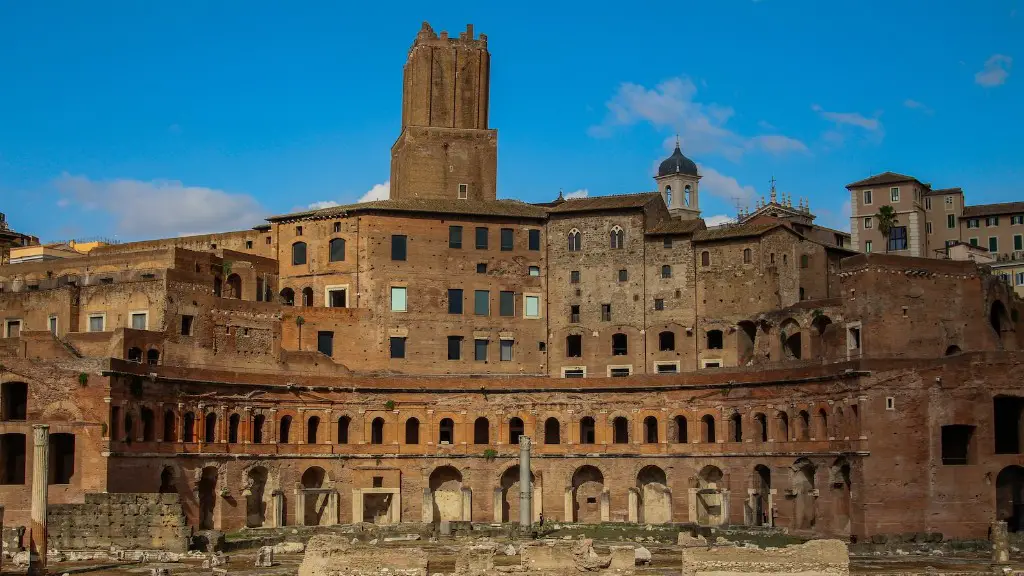Ancient Rome is arguably one of the most successful and influential civilizations in world history. From its founding in 753 BC until its fall in 476 AD, Rome became a major superpower. This period of Roman imperialism, economic success, and cultural advancement are often referred to as the Pax Romana, meaning “the Roman Peace”, and it is seen by some as the peak of Ancient Rome. In this article, we will explore when Ancient Rome was at its peak and what factors made it a major superpower.
The Roman Empire is often dated from when Julius Caesar took power in 49 BC, though historians dispute this date, placing it as early as 27 BC. During this period of Roman expansion, it saw Asia Minor, Egypt, and Judea conquered, as well as most of the barbarian tribes in Europe controlled, including the Gauls and the Goths. This allowed Rome to become the sole superpower in the Mediterranean and the most prosperous state in Europe. The result was a period of intense economic growth and relative peace which lasted until the 3rd century AD.
The Pax Romana is often described as Ancient Rome’s peak because of the period’s incredible economic, social and political achievements. Rome was able to extend its infrastructure, improve its education and legal systems, and repopulate its cities. The most significant of these accomplishments was the establishment of the Pax Romana, a period of unrivaled Roman peace. This period saw increased trade and communication, fewer wars and invasions of the Roman world, and a more unified and prosperous empire than ever before.
Though the Pax Romana is seen as Rome’s peak, the Roman Empire enjoyed widespread and continued success throughout its existence. There were periods of political, military, and economic instability, but these were each followed by periods of peace and prosperity. It is likely that the Pax Romana is seen as the peak of the Roman Empire because it was the longest and the most stable period of its existence, lasting some 250 years.
One of the most significant aspects of the Pax Romana that made it so stable and prosperous was its strong bureaucracy. Rome employed civil servants and government officials to manage its vast and far-reaching empire. These officials were highly efficient and managed to keep much of the Roman Empire intact. This ensured that trade and communication were conducted quickly and smoothly, and allowed Rome to expand its reach and influence with relative ease.
Other factors that contributed to the Pax Romana’s success were the Roman army, Rome’s cultural values and religious beliefs, the Roman legal system, and the Pax Deum, or “God’s Peace”. The Roman army was highly organized and effective, allowing them to protect Rome’s borders and expand its territory. Roman culture was highly influential, providing a sense of unity and purpose among Roman citizens. The Roman legal system provided fair and equitable laws for citizens and was renowned for its fairness and impartiality. Finally, the Pax Deum was the idea that Rome was favored by the gods, granting it the power and authority to govern with authority and justice.
Role of Religion.
The role of religion in the Pax Romana was significant. Rome’s pantheon of gods and goddesses was influential and provided a sense of stability and continuity. The Roman state and its citizens worshipped these deities and believed they were responsible for Rome’s success. Religion was an important part of Roman life and culture, with temples, festivals and rituals devoted to the gods. Religion provided a sense of purpose and shared belief that helped to keep the Roman Empire united and strong.
Role of Emperors.
The emperors of Ancient Rome also played an important role in ensuring the Pax Romana remained in place. The emperors of Rome were all aided by a talented bureaucracy and military, as well as a strong set of laws and customs. They used their authority to ensure that laws were enforced and that justice was maintained, but also ensured that the Pax Romana was maintained by avoiding wars and expanding the control of the Roman Empire.
Effects of the Pax Romana.
The Pax Romana had a lasting effect on the Roman Empire and the world. It allowed Rome to extend its infrastructure and population, leading to increased trade, communication, and knowledge. It also allowed Rome to spread its culture and influence throughout Europe, and the laws and values of Rome were adopted by many people in the region. The Pax Romana also allowed the Roman Empire to remain strong and unified until its fall in 476 AD, after which it continued to influence Europe and the world for centuries.
Decline of the Pax Romana.
Though the Pax Romana was hugely successful, it eventually began to decline. The Roman economy began to suffer, as invading barbarians began to plunder Roman wealth. The bureaucracy and military also began to weaken, leading to increased levels of corruption, crime, and civil unrest. This period of turmoil and instability lasted until 476 AD, when the Roman Empire officially ended.
Conclusion.
The Pax Romana is widely seen as the peak of the Ancient Roman Empire, due to the period’s incredible economic, social, and political achievements. During this time, Rome was able to expand its infrastructure and repopulate its cities. The Pax Romana allowed Rome to remain unified, prosperous, and powerful until its fall in 476 AD, and its legacy continues to influence the world today.


